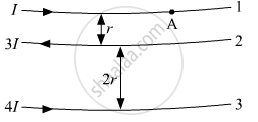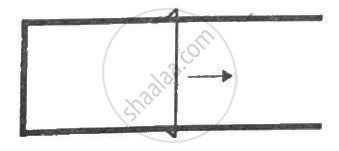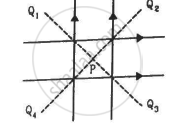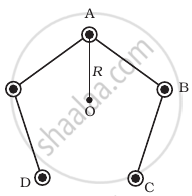Advertisements
Advertisements
प्रश्न
The figure shows three infinitely long straight parallel current carrying conductors. Find the
(i) magnitude and direction of the net magnetic field at point A lying on conductor 1,
(ii) magnetic force on conductor 2.

उत्तर
(i) Magnetic field due to a straight infinite long straight wire carrying current is given by

Current in wire 2 is 3I
\[B_2 = \frac{\mu_o}{4\pi}\frac{2 \times 3 I}{r}\]
\[ B_2 = \frac{\mu_o}{4\pi}(\frac{6 I}{r})\]
\[\text { The direction of magnetic field at point A due to wire 2 is in inward direction } . \]
Magnetic field (B3) at point A due to charge carrying wire 3
Current in wire 3 is 4I
\[B_3 = \frac{\mu_o}{4\pi}\frac{2 \times 4 I}{r + 2r}\]
\[ B_3 = \frac{\mu_o}{4\pi}(\frac{8 I}{3r})\]
\[\text { The direction of magnetic field at point A due to wire 3 is in the outward direction } . \]
\[\text { Net Magnetic field at point A }\]
\[B = B_2 - B_3 \]
\[ = \frac{\mu_o}{4\pi}(\frac{3 I}{r}) - \frac{\mu_o}{4\pi}(\frac{8 I}{3r})\]
\[ = \frac{\mu_o}{4\pi}(\frac{I}{3r}) \]
\[\text { The direction of net magnetic field at point A is in inward direction } . \]
(ii)
Magnitude of force on wire 2 due to wire 1
\[F_{21} = \frac{\mu_o}{4\pi} \frac{2 I_2 I_1}{r}\]
\[ = \frac{\mu_o}{4\pi}\frac{2 \times 3I \times I}{r} = \frac{\mu_o}{4\pi}\frac{6 I^2}{r}\]
\[\text { Magnitude of force on wire 2 due to wire } 3\]
\[ F_{23} = \frac{\mu_o}{4\pi} \frac{2 I_2 I_3}{r}\]
\[ = \frac{\mu_o}{4\pi}\frac{2 \times 3I \times 4I}{2r} = \frac{\mu_o}{4\pi}\frac{12 I^2}{r}\]
\[\text { Net force on wire 2 } = F_{23} - F_{21} \]
\[ = \frac{\mu_o}{4\pi}\frac{12 I^2}{r} - \frac{\mu_o}{4\pi}\frac{6 I^2}{r}\]
\[ = \frac{\mu_o}{4\pi}\frac{6 I^2}{r}\]
APPEARS IN
संबंधित प्रश्न
What is the magnitude of magnetic force per unit length on a wire carrying a current of 8 A and making an angle of 30° with the direction of a uniform magnetic field of 0.15 T?
Derive the expression for force per unit length between two long straight parallel current carrying conductors. Hence define one ampere.
An electron is moving along the positive x-axis. You want to apply a magnetic field for a short time so that the electron may reverse its direction and move parallel to the negative x-axis. This can be done by applying the magnetic field along
(a) y-axis
(b) z-axis
(c) y-axis only
(d) z-axis only
A long, straight wire of radius R carries a current distributed uniformly over its cross section. T he magnitude of the magnetic field is
(a) maximum at the axis of the wire
(b) minimum at the axis of the wire
(c) maximum at the surface of the wire
(d) minimum at the surface of the wire.
Figure shows a metallic wire of resistance 0.20 Ω sliding on a horizontal, U-shaped metallic rail. The separation between the parallel arms is 20 cm. An electric current of 2.0 µA passes through the wire when it is slid at a rate of 20 cm s−1. If the horizontal component of the earth's magnetic field is 3.0 × 10−5 T, calculate the dip at the place.

Four long, straight wires, each carrying a current of 5.0 A, are placed in a plane as shown in figure. The points of intersection form a square of side 5.0 cm.
(a) Find the magnetic field at the centre P of the square.
(b) Q1, Q2, Q3, and Q4, are points situated on the diagonals of the square and at a distance from P that is equal to the diagonal of the square. Find the magnetic fields at these points.

According to Ampere's circuital law, ______.
Do magnetic forces obey Newton’s third law. Verify for two current elements dl1 = dlî located at the origin and dl2 = dlĵ located at (0, R, 0). Both carry current I.
Five long wires A, B, C, D and E, each carrying current I are arranged to form edges of a pentagonal prism as shown in figure. Each carries current out of the plane of paper.

- What will be magnetic induction at a point on the axis O? AxisE is at a distance R from each wire.
- What will be the field if current in one of the wires (say A) is switched off?
- What if current in one of the wire (say) A is reversed?
Beams of electrons and protons move parallel to each other in the same direction. They ______.
